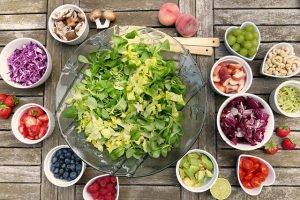Not Much Energy
 Sometimes, you have only a little available electricity or energy for cooking and have to use as little as possible, in order to keep energy for other days. Here are some ideas for a fast nutritious budget meal.
Sometimes, you have only a little available electricity or energy for cooking and have to use as little as possible, in order to keep energy for other days. Here are some ideas for a fast nutritious budget meal.
Sometimes, the freezer or fresh section of your local supermarket may have some ready foods on offer that will be quick to cook, such as burgers or fish fingers or even pizza. These will not take much of your cooking energy to heat thoroughly to give you a quick hot meal.
Fast cook budget foods
Stir-Fry
Stir-fry is a versatile option that can be made with a variety of vegetables and proteins. Simply sauté your choice of vegetables (such as bell peppers, broccoli, carrots) with a protein source (chicken, tofu, shrimp) in a hot pan with some oil and soy sauce. Serve over rice or noodles.
Pasta with Tomato Sauce
Pasta is quite possibly the cheapest meal on 5 continents, especially if you only have pasta available. Try melting some butter or spread on top if you don’t have anything else. (Student stand by)
Boil pasta (spaghetti, penne, or any type you prefer) and toss it with canned tomato sauce. Add some sautéed onions, garlic, and a pinch of herbs for added flavor. You can also add vegetables like spinach, bell peppers, or mushrooms.
Omelette or Scrambled Eggs
Eggs are a quick and cheap source of protein. Make an omelette or scrambled eggs with diced vegetables (onions, tomatoes, spinach) and cheese. Serve with whole wheat toast. Very fast and full of nutrition.
Hard boiled Eggs
Boil up a number of eggs at once (hard boil) then shell them and store in the fridge for use over a couple of days.
Rice and Beans
Cook rice and beans (canned or dried, depending on your time) and season them with cumin, chili powder, garlic powder, and a bit of hot sauce. This is a simple and filling dish.
Grilled Cheese Sandwich
Make a classic grilled cheese sandwich by placing cheese between two slices of bread and grilling it in a pan until the cheese is melted and the bread is crispy. Alternatively make a faux pizza by toasting a slice of bread, adding some tomato sauce and sliced or grated cheese and then grilling til the cheese is golden and bubbling.
Vegetable Quesadillas
Fill a tortilla with shredded cheese and your choice of sautéed vegetables. Fold it in half and cook it on a pan until the cheese is melted and the tortilla is crispy.
Instant Noodles with Vegetables
While not the healthiest option, instant noodles can be made more nutritious by adding some chopped vegetables and a boiled egg.
Canned Soup and Crackers
Opt for low-sodium canned soup and pair it with whole grain crackers or a slice of bread.
Pita Bread Pizzas
Top whole wheat pita bread with tomato sauce, shredded cheese, and your choice of toppings. Toast in the oven until the cheese is melted.
Salad with Canned Tuna or Beans
Create a quick salad using lettuce or spinach, canned tuna or beans, chopped vegetables, and a simple vinaigrette dressing.
Microwave “Baked” Potato
Pierce a potato with a fork and microwave it until tender. Top with canned chili, cheese, sour cream, or your favorite toppings.
Homemade Fried Rice
Cook leftover rice with chopped vegetables, scrambled eggs, and soy sauce. Add a protein like diced ham, tofu, or cooked chicken if you have it.
Veggie Wrap
Spread hummus or cream cheese on a tortilla and add sliced vegetables (cucumbers, bell peppers, carrots) and greens. Roll it up for a quick wrap.
Couscous Salad
Prepare couscous according to the package instructions and toss with chopped vegetables, canned beans, and a simple vinaigrette.
One-Pot Pasta
Cook pasta in a single pot with broth, diced tomatoes, and your choice of vegetables and seasonings. It’s a simple way to minimize cleanup.
Black Bean Tacos
Warm canned black beans and season with cumin and chili powder. Serve in tortillas with lettuce, salsa, and cheese.
Frittata or Crustless Quiche
Whisk eggs with milk, add sautéed vegetables and cheese, then bake until set. Enjoy a slice of frittata for multiple meals.
Ramen with Upgraded Ingredients
Enhance instant ramen by adding fresh vegetables, a cracked egg, and some sliced cooked meat.
Pancakes for Dinner
Make pancakes using a simple batter of flour, milk, and egg. Serve with peanut butter, yogurt, or fruit for added nutrients.
Quick Bean Burritos
Fill tortillas with canned refried beans, cheese, and salsa. Microwave or heat in the oven until warm.
Quick Veggie Soup
Simmer canned vegetable broth with chopped vegetables, canned diced tomatoes, and a can of beans for a fast and nutritious soup.
Mini Pizza Bagels
Top halved bagels with tomato sauce, shredded cheese, and your favorite pizza toppings. Toast until the cheese melts.
Open-Faced Tuna Melt
Top whole wheat bread with canned tuna mixed with a bit of mayo and diced celery, then add a slice of cheese and broil until bubbly.
Microwave Steamed Vegetables
Steam frozen vegetables in the microwave and season with herbs, butter, or a sprinkle of cheese.
Oatmeal with Toppings
Prepare instant oats and top with sliced bananas, nuts, dried fruits, or a spoonful of yogurt.
Remember to adjust these ideas to your taste preferences and dietary needs. With a little creativity, you can whip up a variety of tasty and economical meals in no time. Remember, while these meals are quick and budget-friendly, it’s always a good idea to include a variety of foods to ensure you’re getting a balanced diet. You can modify these ideas to suit your preferences and dietary needs.

 These can be consumed raw. Some examples include:
These can be consumed raw. Some examples include: